Best acoustic guitar pickups 2025: electrify your acoustic for stage, studio and sound fx – our top picks for all budgets
Looking to perform live, record in a studio or hook up your acoustic guitar to some dazzling effects? Then fitting a quality pickup is the best upgrade you can make
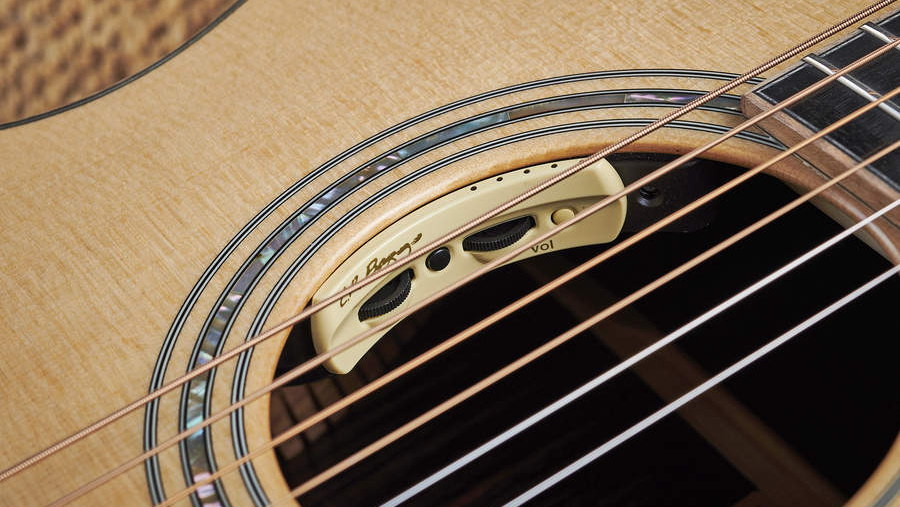
If you have a burning desire to perform live, record, or experiment with effects but your acoustic guitar lacks a pickup, don’t worry; I can help you discover the best acoustic guitar pickups that sound just as good, if not better, than factory installs.
Adding a pickup to your acoustic guitar rewards you with opportunities and buys you convenience. While it is possible to rig up external mics to capture your guitar’s acoustic tone, it’s a hassle and only viable if you’re sitting still while playing, which rarely makes for the most thrilling performance.
It may be the norm for fine recordings, but even within a studio setting, a pickup is a more immediate solution, enabling you to lay down plug-and-play demo tracks without fuss. Even if you’re a novice, I still recommend buying a pickup, as it'll let you record your practice sessions, hook up to some learning apps, and have a lot of fun with a looper pedal.
Don’t let the installation phase you. Fitting electronics is rarely beyond the ability of anyone handy enough to turn a screwdriver or squeeze a tube of glue, but if working on your guitar worries you, a local luthier should be able to assist with even the trickiest of installations.
I’ve compiled my top picks for the best acoustic guitar pickups below. Pickups vary by tech and application, so do read my deep dive to discover the most suitable one for your needs. If you'd like to know my top pick before diving into the complete guide, I've chosen the ever-popular LR Baggs Anthem, based on its superb sound quality and versatility.
Check out our FAQs section too, for more helpful insights.
Quick list
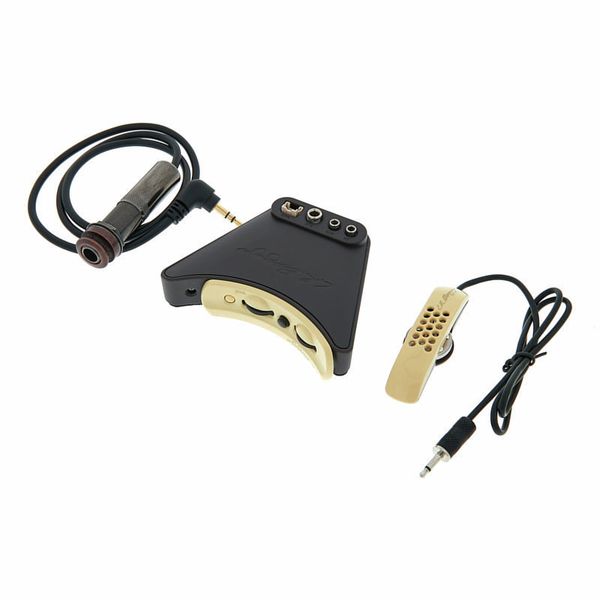
Pro-quality blended piezo and mic system that offers the best of both worlds. The included preamp provides myriad tone-shaping options.
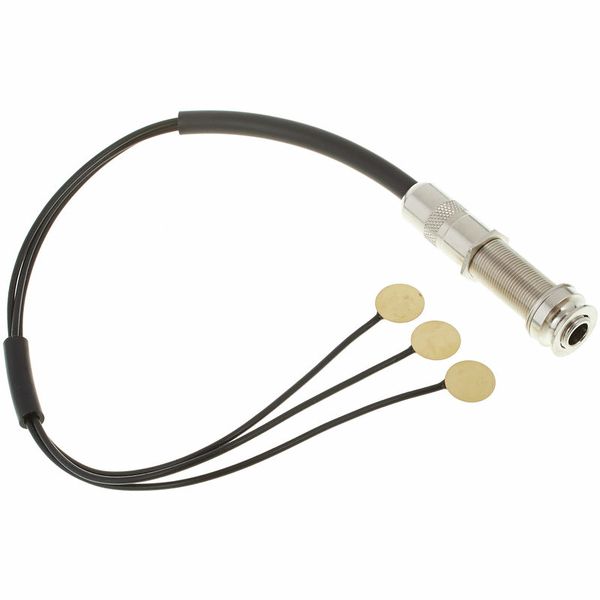
Both inexpensive to buy and straightforward to install, this three-head transducer pickup provides authentic tone for little outlay in time or money.
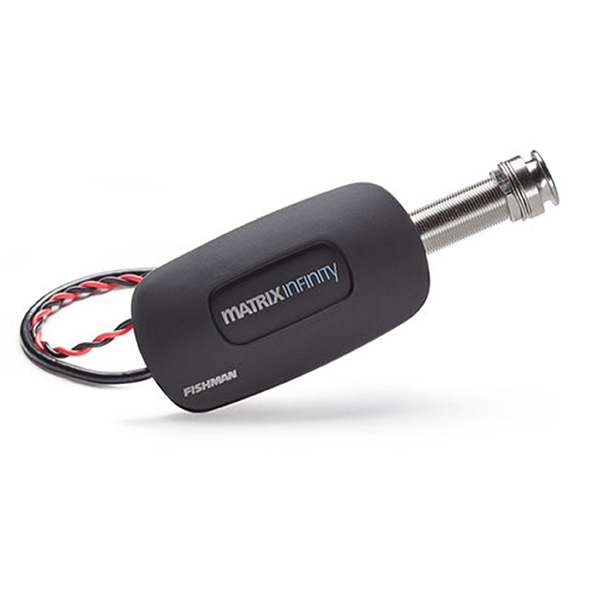
The ‘world’s best-selling undersaddle piezo’ has a variably scooped tonal signature that leaves plenty of space for vocals. A fine-value singer-songwriter favourite.
Best overall

1. LR Baggs Anthem
Our expert review:
Specifications
Reasons to buy
Reasons to avoid
✅ Buy if you're looking for a great all-round option: The LR Baggs Anthem delivers a ton of audio detail - and it's easy to install.
❌ Avoid if you want something a little darker in design: The cream colour variant won't be for everyone.
Installation: ★★★★★
Build quality: ★★★★★
Sound: ★★★★★
Overall: ★★★★★
The combination of a piezo and a mic in a single system offers the best of both worlds, delivering warmth, character and clarity. Retrofitting sophisticated acoustic electronics can be a nerve-wracking experience, but the Anthem system is a dream instal – many of the components, including the internal mic, are easily placed with peel-and-stick adhesive.
The mic ‘floats’ three millimetres from the underside of the bridgeplate, just forward of the bridge pins, while the Element piezo pickup is fitted beneath the saddle (it’s also available to purchase separately).
Once installed, the signals from both the mic and piezo can be blended via a mix control until they are finessed to your taste. In a nutshell, the microphone does most of the heavy lifting, capturing the majority of the guitar’s tone, while the undersaddle piezo is voiced to provide low-end grunt. Slightly counterintuitively, this explains the lack of high-end harshness usually associated with piezo pickups.
The Tru-Mic technology used here delivers a more open sound than the boxy character some mic blend systems often exhibit, as it captures a significant amount of soundboard detail. The preamp controls include volume, mix, phase inversion, battery check, and mic trim.
Best budget
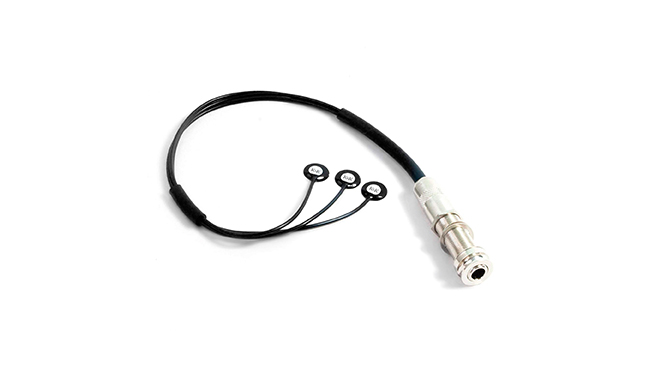
2. K&K Sound Pure Mini
Our expert review:
Specifications
Reasons to buy
Reasons to avoid
✅ Buy if you want an excellent pickup for less: If your budget is tight, you can't go wrong with this. Sure, it's not as complex as some other pickups, but for the price, it's hard to argue.
❌ Avoid if you're a more experienced player: Spending a bit more cash will reward you with better tone.
Installation: ★★★★★
Build quality: ★★★★½
Sound: ★★★★½
Overall: ★★★★½
The K&K Sound Pure Mini is a popular passive pickup that offers good output and a warm, full sound from its three transducers (there’s a classical model too that has four). This trio of sensors is glued to the underside of your guitar’s bridge plate, an area that is less likely to produce feedback than adhering them each to the soundboard itself.
You’ll need good lighting and a mirror to do the work yourself, but the installation is straightforward, provided you have a steady hand to drill out your guitar’s end pin hole for the jack plug. Your reward is the best passive system I've heard for producing an authentic acoustic tone.
The K&K Sound Pure Mini is a bare-bones setup, but a passive volume control is available as an option, and K&K also offers an inexpensive compact external Pure Preamp with bass, mid, treble, and volume controls for enhanced tone-shaping. The preamp even features a belt clip to keep it close at hand on stage.
Best value

3. Fishman Matrix Infinity VT
Our expert review:
Specifications
Reasons to buy
Reasons to avoid
✅ Buy if you want an affordable piezo pickup & preamp combo: This is a discreet pickup that offers versatility and crystal clear sound.
❌ Avoid if you want a straightforward installation process: I advise you to get a luthier to install this pickup - especially if you've never tackled the job before.
Installation: ★★★★
Build quality: ★★★★★
Sound: ★★★★★
Overall: ★★★★★
According to Fishman, the Matrix is the world’s best-selling undersaddle piezo pickup and preamp combo – my take is that it’s undoubtedly the best value for money.
The reason for its enduring popularity, as one of the best acoustic guitar pickups, is simple – it offers a near-complete and clear acoustic sound.
Its one-knob tone control offers a flat non-EQ’d tone at one extreme, to a fully scooped sound at the other. Cutting the mids fairly aggressively, while boosting treble and bass, is an absolute gift for singer-songwriters, while a more subtle cut can help to bring out the detail and clarity in fingerstyle. There’s a voicing switch that boosts bass frequencies too, a useful feature for smaller guitars.
Tone, voicing and volume are all dialled/switched via a control module that’s stealthily positioned inside the soundhole.
The brand offers a variety of fit options, including those for narrow, wide and split saddles. While I would advise getting one of these installed by a luthier, it can be done yourself with the right tools and a good dollop of self-belief in your DIY skills.
Best for pros
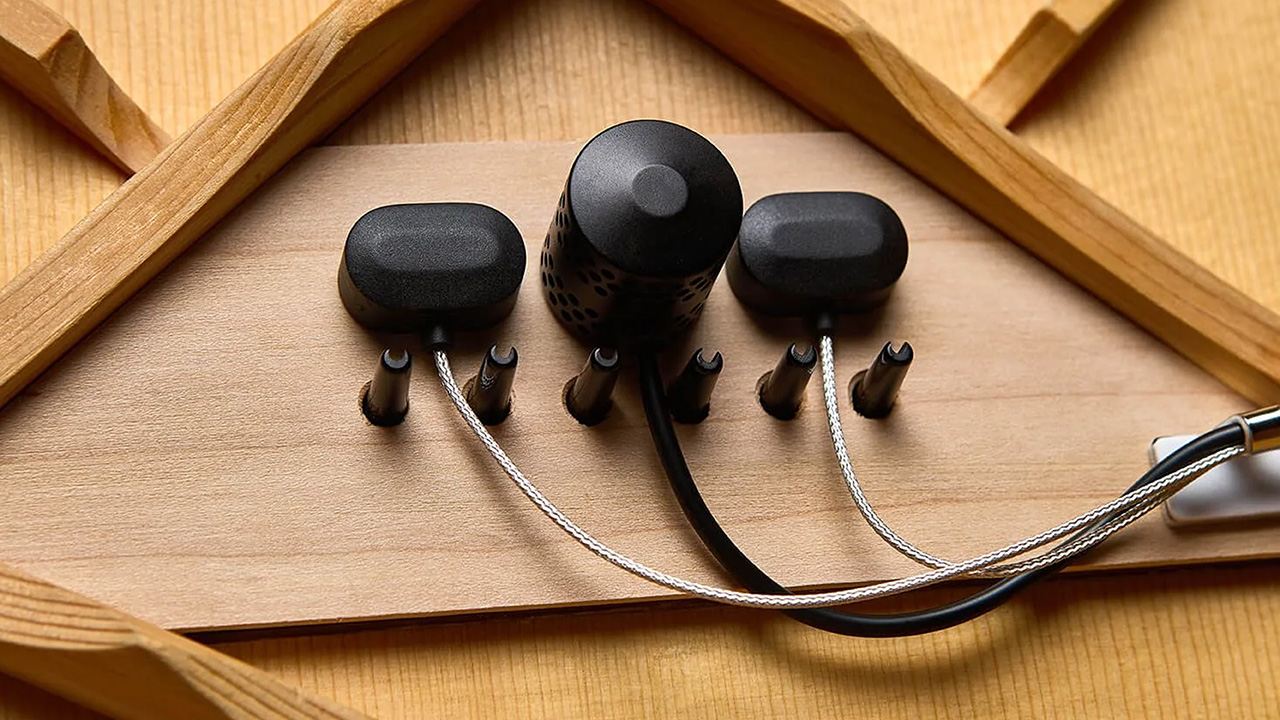
4. LR Baggs HiFi Duet
Our expert review:
Specifications
Reasons to buy
Reasons to avoid
✅ Buy if you're looking to upgrade from the LR Baggs Anthem: The HiFi Duet is a step up in quality, tone and price from the Anthem and is a great choice for pro players.
❌ Avoid if you're just starting out: There are cheaper and better options in this list if you're a novice.
Installation: ★★★★
Build quality: ★★★★★
Sound: ★★★★★
Overall: ★★★★★
The world of acoustic guitar pickups revolves slowly, with many products dating back years, if not decades. So, it’s refreshing to feature a more contemporary product in this buyer’s guide – the HiFi Duet from LR Baggs.
As the name Duet implies, it’s a blended system, one that combines the brand’s existing HiFi bridgeplate transducers, introduced in 2023, with a brand-new microphone, named the Silo. Why the odd name? The capsule housing is reminiscent of a grain silo, but thankfully, much, much smaller.
The transducer set received favourable reviews at launch for its ability to reproduce depth, definition, and dynamics. Now, adding a microphone enhances authenticity, airiness, and ambience. It’s a given that this combination performs well on stage, but it can also rival some studio microphone setups. Naturally, while you benefit from easier setup in the studio with the HiFi Duet, you do sacrifice some flexibility in microphone placement. Overall though, it remains an invaluable solution.
All three pickup components – the two transducers and the mic capsule – are sticker-mounted to the bridgeplate, greatly simplifying installation. The accompanying preamp and control module is also a stick fit. LR Baggs recommends that the entire system is installed by a professional, but it’s not beyond the scope of a patient, fastidious amateur.
Interestingly, despite being mounted on the bridgeplate, the microphone capsule is shock-mounted, so it doesn't pick up any mechanical energy from the guitar’s top, only your instrument’s air-borne tone. Blending it with the transducers is controlled via a rotary dial on the preamp.
In case you're wondering, this product bears many similarities to the excellent LR Baggs Anthem, which uses an undersaddle piezo pickup rather than a pair of bridgeplate transducers. However, the HiFi Duet is a step up in quality, tone and price.
Best for percussive playing
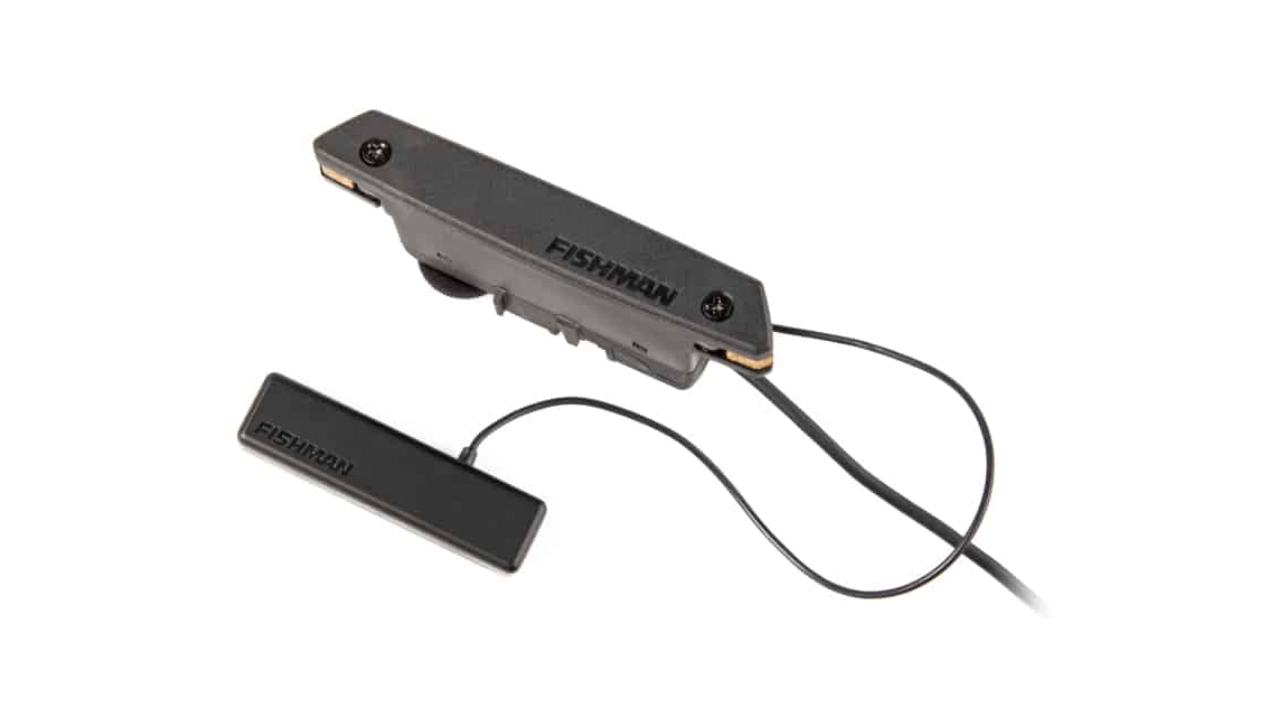
5. Fishman PowerTap Earth
Our expert review:
Specifications
Reasons to buy
Reasons to avoid
✅ Buy if you want the audience to hear practically everything: Knocks, taps and more are picked up really well with the PowerTap Infinity - perfect for the percussive players out there.
❌ Avoid if you need a few more bells and whistles: The humbucker only has basic blend control which is a bit disappointing.
Installation: ★★★★½
Build quality: ★★★★½
Sound: ★★★★½
Overall: ★★★★½
Percussive playing - tapping and the like - has become all the rage over the past few decades, prompting guitarists to re-evaluate what they want to hear through the PA. Once upon a time, we would have settled for a close-to-authentic guitar tone, the experience of delightfully sonorous notes drifting artfully from speaker to audience as we performed. These days, that's no longer enough. We want our public to hear our every touch, our every tap, our every last percussive knock.
With the Fishman PowerTap Earth they can. At the heart of this system is the PowerTap body sensor, a small bridgeplate-mounted module that accurately picks up playing dynamics. In Fishman-speak, that's touch, ambiance and percussion, hence the Tap moniker. Whoever dreamed that acronym up must have been very proud of themselves.
Here, the sensor is combined with Fishman's excellent Rare Earth humbucker, effectively replacing a microphone in a typical dual-unit setup. Is this wise? Absolutely. I found the sensor delivered a spacious, 3D-like quality to my playing, infusing both the percussive elements and our natural picking dynamics too.
The icing on the cake is you can split the output signal, routing humbucker and body sensor to separate amps, effects and so on. For example, you can add a little more reverb to the humbucker or go wild, adding extra delay to the sensor. The PowerTap opens up so many creative opportunities.
Downsides? The humbucker option features only a basic blend control, which seems a little mean. Alternatively, the pricier Jon Gomm signature series PowerTap Earth Pro adds a mic, a preamp and superior tone control options.
If that’s beyond your budget, or you just prefer an undersaddle piezo pickup to a soundhole-mounted humbucker, the PowerTap Infinity includes both volume and tone controls. It’s well worth a look too.
Best noise-cancelling
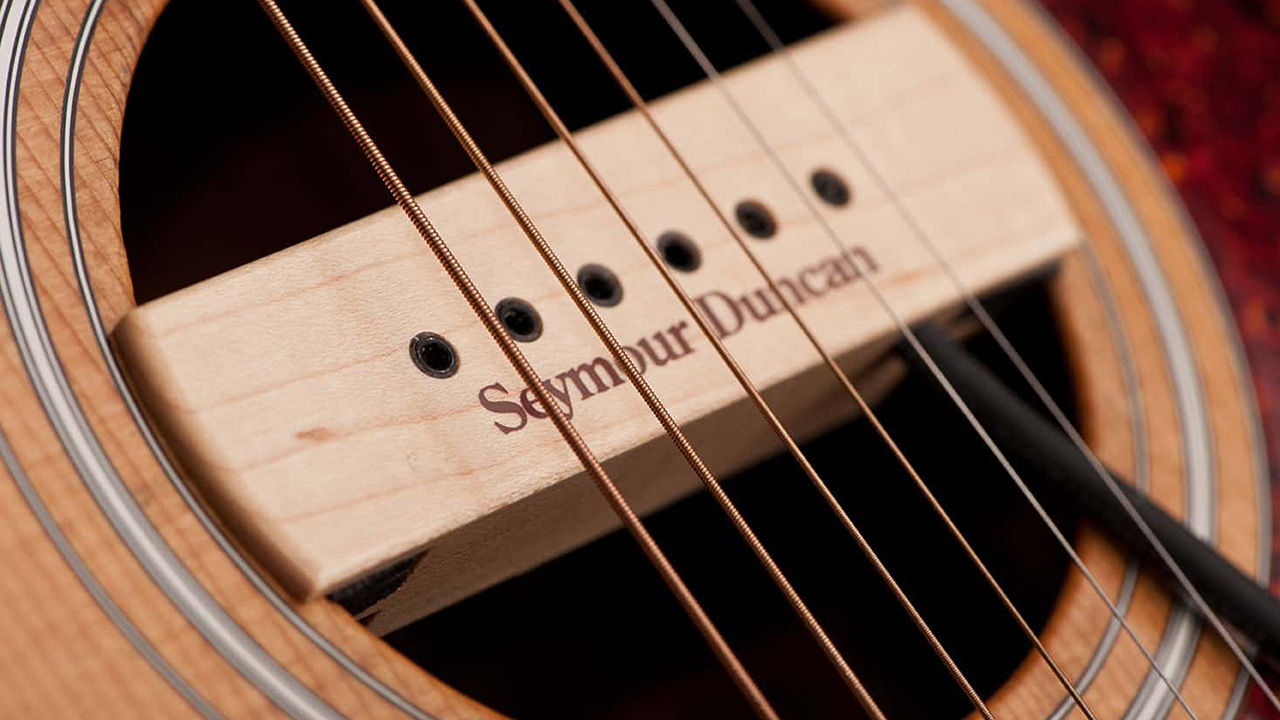
6. Seymour Duncan Woody XL SA-3XL
Our expert review:
Specifications
Reasons to buy
Reasons to avoid
✅ Buy if you want a no-fuss, easy to install pickup: The Woody XL is easy to install and comes in black, maple and walnut finishes.
❌ Avoid if you like to keep things neat and tidy: The trailing cable is likely to annoy you pretty quickly if you like things well-organised.
Installation: ★★★★½
Build quality: ★★★★
Sound: ★★★★½
Overall: ★★★★½
Despite being named XL, this pickup is more of a happy medium, combining the best qualities of both humbucking and single-coil magnetic soundhole pickups to deliver a well-balanced tone. Not only does it sound excellent, it’s also quick and easy to install.
Single-coil pickups successfully capture the jangly highs so readily associated with the sound of an acoustic guitar, but unfortunately, they’re predisposed to suffer from 60-cycle hum. As their name suggests, humbucking pickups are much less prone to noise, but they often fail to produce the top-end sparkle that single coil pickups are renowned for.
The Woody XL is a passive magnetic soundhole humbucker voiced to reproduce as much of that glorious high-end as possible, while still retaining a fat, warm bottom end. As such, it’s very slightly more expensive than its SA-3HC (humbucker) and SA-3SC (single coil) stablemates, but, in my opinion, well worth the additional investment.
It’s a treat to install because it simply clips into place. Available in black, maple, and walnut finishes, its only drawback is its trailing lead, which may annoy some.
Best for blues
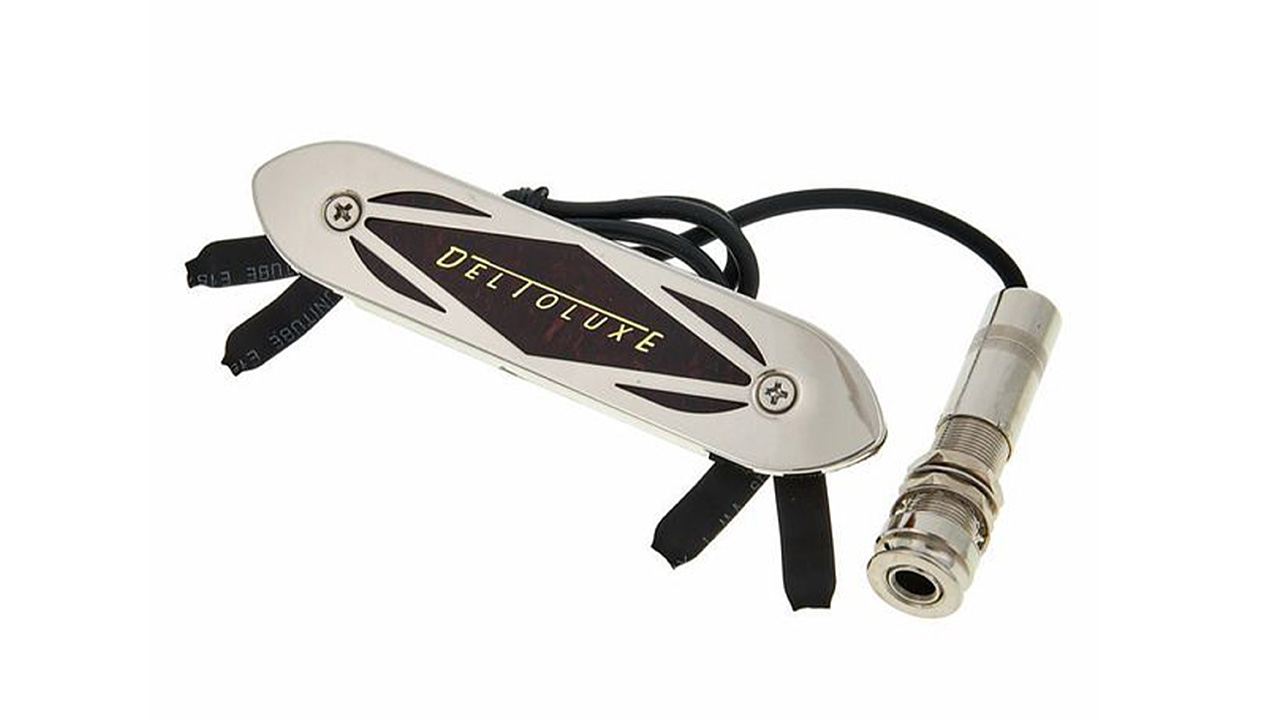
7. Gretsch Deltoluxe
Our expert review:
Specifications
Reasons to buy
Reasons to avoid
✅ Buy if you want great-sounding pickup with a retro flourish: I'm a big fan of the Gretsch Deltoluxe's design - and thankfully it performs just as good as it looks.
❌ Avoid if you play a larger guitar: Jumbo players might find this particular pickup a bit too small for their needs.
Installation: ★★★★½
Build quality: ★★★★½
Sound: ★★★★½
Overall: ★★★★½
Most guitarists aim to coax the most natural tone possible from their electric acoustic guitars. The Gretsch Deltoluxe, then, is not for them. It delivers a warmer, grittier tone that will appeal to lovers of acoustic soulful blues, Delta slide, blues-tinged jazz and so on.
That said, the effect conjured up by its Alnico 5 poles is quite subtle, one best suited to the compressed, mid-focused sound of small parlour-sized guitars. It’s a passive single-coil pickup that nonetheless sounds quite thick, making it an infinitely better choice for these genres than a potentially sterile-sounding undersaddle piezo. The lack of tonal control may frustrate some, but it’s unreasonable to expect more at this price.
This is a pickup you should be able to install yourself, provided you’re happy enlarging your guitar’s end-pin hole with a drill. Thankfully, there’s no soldering, or complex wiring to worry about.
Last, but not least, the Gretsch Deltoluxe, with its retro vibe, is a bit of a looker – one of the very few soundhole-mounted pickups that enhances a guitar’s appearance rather than detracting from it.
Spec comparison
Pickup | Type | Price |
|---|---|---|
LR Baggs Anthem | Preamp, condenser mic and undersaddle piezo system | £255/£299 |
K&K Sound Pure Mini | Passive bridgeplate three-head piezo transducer set | £129/$159 |
Fishman Matrix Infinity VT | Undersaddle piezo and preamp. Three fit options: narrow, wide and split saddle | £189/$219 |
LR Baggs HiFi Duet | Preamp, condenser mic and bridgeplate transducers | £449/$459 |
Fishman PowerTap Earth | Active magnetic soundhole pickup and soundboard body sensor | £239/$319 |
Seymour Duncan Woody XL SA-3XL | Passive humbucker pickup | £149/$99 |
Gretsch Deltoluxe | Passive single-coil soundhole pickup with Alnico 5 magnets | £59/$89 |
How to choose the best acoustic guitar pickup for you
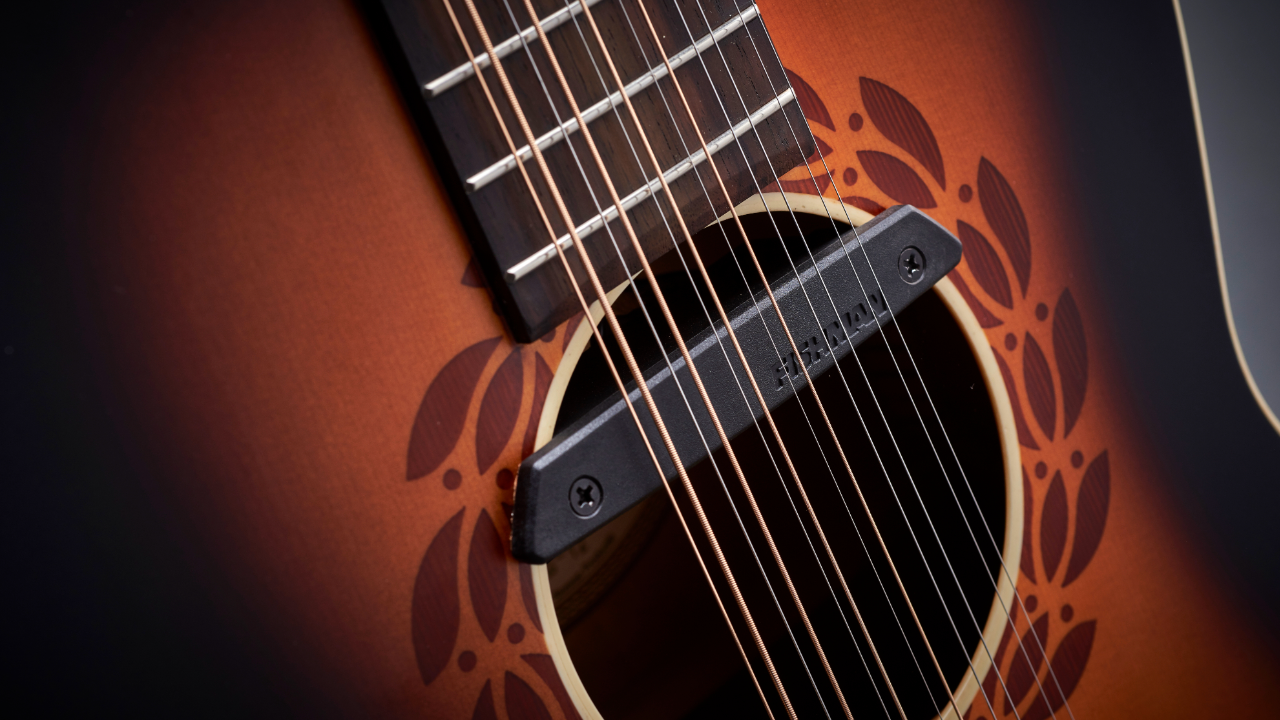
It's a funny old world isn't it? Take any top-end electric guitar and, quite understandably, you'll expect it to be made from the finest tone woods available. We guitarists demand that natural and sunburst finishes showcase every last square inch of exquisite figuring, or that solid paintwork is so thinly applied that even the subtlest grain shows through.
Take any top-end acoustic and it's a similar story. We want to see every angel step, bee's wing, cat's paw, flame, pommele and ribble. Aesthetics is really important.
Back to that dream electric, the pickups will be a stand-out visual feature. Burnished, chromed, engraved, gold foiled, painted in camo or decorated in cartoon figures, electric guitar pickups proudly assert that this is an instrument that boasts muscular output and sublime tone.
A visible acoustic pickup, on the other hand, is viewed as an unwanted appendage. Something to be hidden out of sight – an ugly necessity that we'd rather pretend to ourselves, and our audiences, isn't there.
The fact is, pickups are fêted on an electric guitar but often scorned on an acoustic. Of course, electric guitar pickups are fundamental to the tone of the instrument, whereas acoustic pickups are seen as a necessary evil that, if you don't pick carefully, only approximate the original sound characteristics of your beloved guitar.
So, when choosing an acoustic pickup there are two primary factors to consider: tone and aesthetics. But, before we delve deeper into these two topics it's important to discover why you should buy a pickup for your acoustic guitar in the first place.
Glossary of terms
- Active Pickups: These pickups use a battery to boost the signal, resulting in a higher output and reduced noise. They often have a more significant tonal range compared to passive pickups.
- Dynamic Range: The range between the quietest and loudest sounds a pickup can capture. A wider dynamic range allows for more expressive playing.
- Frequency Response: Refers to the range of frequencies that a pickup can capture effectively, influencing how bright or warm your guitar sounds.
- Humbucker: These pickups are great for reducing interference and providing a fuller sound, withing the buzz or hum of a single-coil.
- Magnetic Pickup: The most common type of pickup, which uses magnets and coils of wire to convert string vibrations into an electrical signal.
- Neodymium: A type of magnet used in some pickups, known for its strength, allowing for a smaller and lighter design while maintaining high output.
- Piezo: This pickup type uses pressure-sensitive crystals to capture the vibrations of the guitar body, often used in acoustic guitars for a more natural sound.
- Passive Pickups: Unlike active pickups, these don’t require a battery. They typically have lower output and a more organic sound, with no added gain.
- Single-Coil: A type of pickup made with one coil of wire. They have a bright, clear tone but can be more susceptible to noise and interference.
- Transducer: A device that converts energy from one form to another, often used interchangeably with pickups, especially in acoustic guitars.
FAQs
Why fit an acoustic guitar pickup?
Why? Because a pickup will reveal an entirely new dimension to your guitar and your playing.
The obvious advantage of installing a pickup is the additional volume you'll benefit from when playing bigger venues. In fact, performing solo anywhere larger than a medium-sized room will probably require amplification, and if you're fighting to be heard above bandmates then you'll need some way of boosting your sound from the get-go.
What if you're a complete novice, months if not years away from performing in front of a large crowd? We'd still recommend fitting a pickup to your guitar because it will revolutionise your practice regime, especially if you've already got access to an amp or a DAW. Listening back to your playing is a vital part of practicing that many novices avoid because of the hassle involved in miking up a guitar. Fit a pickup and suddenly recording becomes a breeze, literally a matter of plug 'n play.
If you're beyond the early novice stage a pickup opens up a whole new world of dazzling effects – reverb, delay and chorus just for starters. Perhaps the most versatile, and one we'd definitely recommend because it's so much fun, is a looper. Armed with just a looper and an inexpensive amp (it doesn't have to be a dedicated acoustic guitar amp) you can quickly build up extensive, layered masterpieces that will supercharge both your creative skills and your timing.
Which acoustic pickup should I buy?
Let's get one thing straight, before adding to the muddle by contradicting ourselves! An acoustic guitar pickup is not a microphone. Simplistically, a microphone works by converting moving air – sound waves – into electrical voltage. Piezo acoustic guitar pickups, which are a form of transducer, are sensitive to vibrations from a solid surface – most likely your guitar's soundboard or bridge – and, under pressure, convert those vibrations into voltage. Lastly, magnetic coil pickups convert the vibration of your (magnetic) acoustic guitar strings into voltage.
It's useful to understand the difference in order to appreciate why each technology sounds different. When an audience listens to us playing they're hearing sound waves, quite literally moving air, so it follows that a microphone will capture the most authentic acoustic listening experience. It's just too bad they're often a pain to set up and use. All of the other solutions are picking up vibrations from a small part of the body of the instrument, or the strings, which unfortunately makes their capacity for producing an authentic reproduction somewhat limited.
Now for the contradiction. Some of the best-known acoustic guitar pickup products feature microphones, usually in partnership with a piezo transducer. Life's complicated enough, so you'll often find them labelled 'acoustic pickups' for convenience. We're going to include them in this guide too.
All these solutions have their fair share of advantages and disadvantages, so let's run through the pros and cons.
Microphones
As I've already alluded to, large, standalone, external microphones produce the best possible results, but set-up can be agonisingly hit and miss. For obvious reasons they're not suited to exuberant live performances either. Some small instrument microphones, such as the DPA 4099 and Audio Technica ATM350GL, are designed to be clamped to the outside of your guitar where they can give stellar results. They may look a little awkward, but they are a wonderful solution for solo classical performances or any other musical genre where the guitar and guitarist remains relatively still.
Another advantage of using these instrument mics is cost. They're not cheap but they can easily be moved between any guitar in your collection without a messy, potentially damaging install/uninstall.
The downside of using a microphone, other than set-up time and the risk of moving beyond its reach, is that it can pick up a lot more than just your guitar. Finger noise, your breathing, other performers, air con, traffic noise, audience members – you name it, it'll find it. Microphones are also prone to feedback.
Undersaddle pickup
An undersaddle pickup is a thin strip of crystal piezo conductor that converts vibrations into voltage. As the name suggests, it sits in the saddle slot, hidden directly beneath the saddle. Cosmetically, there's no clue a pickup has been installed other than the subtle tell-tale sign of an endpin jack.
Generally, undersaddle pickups can sound very good, but because the vibration source is weighted more towards the strings than the body of the guitar they can lack authenticity. Additionally, because of their placement they tend to have quite a hard tonal character – they're often accused of sounding 'quacky' and a bit on the bright side.
On the, ahem, bright side, they are relatively easy to install. Just one small hole needs to be drilled at the base of the saddle slot, plus another for the endpin jack. The saddle will also need to be shaved down a tad. Uninstalling an undersaddle pickup is also very easy but will require a new saddle or shim.
Bridge plate transducer
A bridge plate transducer comprises three or four piezo transducers, typically the size of small coins, that sit inside your guitar on the bridge plate, usually positioned directly under the saddle. Once again, they make for a very neat, completely covert install.
Judging one pickup type against another is always going to be subjective but the consensus is that a good bridge plate transducer can sound more natural than an undersaddle pickup. Certainly, the lower mids and bass are a lot more pronounced. Nevertheless, they can still sound a bit sterile when compared to a microphone.
Bridge plate transducers, together with their close cousins soundboard transducers, can be heavily influenced by a guitar's tone woods, build and bracing. It stands to reason that the more freely a guitar vibrates, the more voltage a piezo transducer will produce. Therefore, heavily built guitars, or those with more robust bracing, may sound substantially less powerful than their lighter-built counterparts. Something to bear in mind if you're demoing a bridge plate transducer on somebody else's guitar.
Installation is slightly fiddlier than for an undersaddle pickup because you'll be working inside the body of your guitar, but it involves nothing that should unnerve a competent DIYer. Because they thrive on vibration, these transducers need to be fixed as tightly as possible to the bridge plate, which is usually achieved by using superglue. Be warned, this does make uninstalling them less straightforward but it's not impossible.
Soundboard transducers, often referred to as ‘contact mics’, work in a very similar way but usually comprise just one slightly larger transducer that can sit anywhere beneath the soundboard (the guitar’s top). When glued or taped away from the bridge, they provide a warmer, more expansive sound than bridgeplate transducers, but can be susceptible to handling noise. However, this isn’t always a disadvantage. The continuing interest in percussive playing has led inventive guitarists to experiment with many different placements across the internal face of the soundboard.
Magnetic coil soundhole pickup
A magnetic coil soundhole pickup is easily identified as a big rectangular lump straddling the soundhole. It looks, and behaves, like an electric guitar pickup with a cluster of magnetic poles/rods or bars/rails readily converting string vibration into voltage.
Both single coil and humbucker versions are available. As you'd expect, the former sound sparkly, clear and bell-like but with the potential for noise. The latter sound warmer, smoother, have a higher output and lack the propensity to hum.
They can perform wonderfully when you play close to the nut but tend to sound progressively more electric as you work your way up the fretboard. And, of course, a magnetic coil pickup will only work with magnetic strings, so if you rock a nylon strung guitar (like Willie Nelson) you'll hear diddly squat.
The main advantage of the soundhole pickup is that they're a doddle to fit. Provided you don't mind a loose cable dangling from your soundhole you can even bodge a temporary install within just a few minutes.
The disadvantages are that traditionally these pickups were unsightly and sounded artificial, but it's worth conceding that the well-known brands have improved both the appearance and sound quality of their pups immeasurably over the past decade or so. They're a good option if you want to invest in just one pickup that can be swapped around a variety of guitars. Or, perhaps you just love the sound of a humbucker in an acoustic, and there's nothing wrong with that.
Internal mic pickups
We've left internal mic pickups for last because invariably they're used in combination with the piezo transducer solutions listed above. Commonly, they're small microphones that are tucked pretty much out of sight, just inside the lip of the soundhole but sometimes you'll find them suspended from a gooseneck too.
Just like the external mic options they sound more authentic, sweeter, more soulful and less strident than piezo transducers. To benefit from the best of both worlds, high-end solutions will include a piezo transducer – undersaddle or bridge plate – and an internal mic, together with a sophisticated preamp. EQ sliders and a blend control enable you to find the best tone possible.
The only disadvantages of these systems are cost and complexity, although installation is still relatively straightforward. Positioning an internal mic can be a frustrating affair, but somewhere close to where the fretboard meets the soundhole should work well. It's a one-time job, so once you've found the sweet spot you're good to go.
If it's on a gooseneck or swivel mount then pointing it towards the back of the guitar will decrease the bass response and vice versa – useful to know if you're often playing venues with less than perfect acoustics.
Blended systems
As mentioned above, internal microphones are typically used in combination with other pickup types. This makes for a powerful, albeit sometimes expensive, solution that can offer the best of both worlds, accentuating tonal authenticity while mitigating drawbacks such as feedback and sterile tone. Signals from the different sources can be mixed, or blended, to taste, enabling you to dial in the tone you want or, at the very least, dial out undesirable characteristics, such as feedback.
Good examples are the Fishman Rare Earth Blend, which combines an internal microphone with a soundhole-mounted humbucker; and the LR Baggs Anthem (link to above BG top spot), which teams an internal microphone with an undersaddle piezo pickup.

Do I need a dedicated acoustic guitar amp?
It depends on your intentions. If you aim to plug your acoustic guitar into your home studio’s audio interface or a live venue’s PA, then no, once the pickup is installed, you’re pretty much all set. I would, however, recommend investing in a preamp if your pickup isn’t already bundled with one.
If you want to produce an amplified sound at home or in a smaller venue that doesn’t have PA, you might need an acoustic guitar amp. I’m being deliberately hesitant because, if you already play the electric guitar, you may already own an amp that will suffice without even realising it.
Some electric guitar amps – such as the Yamaha THR30II – feature a dedicated acoustic guitar setting or ‘flat’ mode. Instead of colouring the tone to add character, which is usually beneficial for the electric guitar, these very balanced, clean settings allow the authentic sound of an acoustic to shine through.
Dedicated acoustic guitar amps have the same flat frequency response, but many also feature mic inputs, which is a significant benefit for singer-songwriters. This makes them very similar to portable PAs, so it's worth considering both options before making a purchase.
Do I need a preamp for my acoustic guitar pickup?
Frankly, many guitarists are very satisfied with a passive, inexpensive, easy-to-install undersaddle or soundhole pickup without ever feeling the need to invest in active circuitry. However, if you gig a lot, find yourself frequently plugging into a mixing desk or just demand the very best audio quality then you'll find a preamp invaluable.
A preamp does much more than just boost your signal. Available as either onboard or external units, most will boast basic tone and volume controls at the very least. More sophisticated units will feature three- or four-band EQ and, if you have a dual mic and piezo transducer setup, a blend control. This enables you to dial in clarity from the piezo or fullness and warmth from the mic to taste.
It's always preferable to EQ your sound as close to the beginning of the signal chain as you can, rather than try to fix tonal issues using your amp or a mixing desk. With a skilful touch, the EQ controls on a preamp can absolutely transform a piezo transducer, replacing that characteristic thin, tinny, synthetic sound with a tone that's both rich and full.
Other popular niceties include impedance matching, tuners, notch filters and phase switching, more of which below.
Will a pickup enable me to use effects pedals?
Yes, it will. In fact, this is a compelling reason for installing a pickup in your guitar from the get-go. Effects pedals fall into several categories, including time-based and modulation-based, with some more readily associated with the acoustic guitar than others. Here’s a handful you must try.
Looper
Not necessarily an effect in the strictest sense, but more a way of life. This is certainly true for guitarists such as Ed Sheeran, KT Tunstall, and Mike Dawes. A looper offers endless opportunities for building (and building) intricately layered solo compositions. Once notoriously complex to operate, modern looper pedals are now surprisingly easy to get to grips with. They are also excellent tools for jamming and reviewing skills.
Reverb
We’re all familiar with reverb pedals – it’s the effect that adds space and airiness to create artificial ambience. It’s possible to simulate everything from small rooms and huge open halls to the vastness of outer space (if only we could hear in the vacuum of space!).
Delay
Often confused with reverb, strictly speaking, delay pedals produce the sound of individual repeated blocks of sound. Delay can sound suitably vintage ’50s - think Buddy Holly – or contemporary ambient – channelling Brian Eno – depending on the application.
Chorus
Rich and shimmering, chorus pedals mimic the sound of nearly identical notes being produced simultaneously – reminiscent of a church choir. The slight variations in pitch and timing can generate a beautiful, full soundscape.
How do I stop feedback when using an acoustic guitar pickup?
All the amplification solutions mentioned here are prone to howling feedback, simply because the acoustic guitar is the perfect volatile feedback making machine. Acoustic guitars are designed and built to resonate, it's a fundamental quality we look for when choosing a fine instrument that sounds agreeably alive in our hands when we're playing it.
Essentially, when the sound of an acoustic is relayed live through a speaker the sound waves produced can further resonate the body of the guitar, causing a feedback loop. In other words, the amplified output is also acting as an input that's then getting re-amplified in a disastrous circuitous loop.
What can be done to save the wail? Simply turning your back to the speaker often helps, or turning the speaker away from your guitar if that's possible. Other low-tech solutions include fitting a soundhole cover to your guitar or moving the internal mic, again if that's possible.
Feedback is more prevalent in the lower register, so EQ can be a great help. If you've invested in a preamp see if you can EQ out the offending frequencies. Better still, if your preamp has a notch filter you may be able to isolate the cause of the feedback without disrupting the tone of your guitar too much.
Howling feedback can also be heightened by phase issues – the slight delay between the sound of your acoustic and its amplified output. Many preamps feature a phase switch that can make your signal in phase, or various states of out of phase. Have a play with this switch to see if it helps but just be aware that out of phase signals can sound weak and lacklustre.
Preamps can sometimes help with impedance mismatches too, another potential cause of feedback. Piezo transducers are fairly high impedance devices, while mixing desks are relatively low impedance. Some preamps can take a high impedance input while matching the low impedance requirements of the desk on output. This can be especially useful because high impedance boosts bass frequencies, which can cause issues with boominess and, you've guessed it, feedback.
How do I install an acoustic guitar pickup?
Installing any one of these pickup solutions is a relatively straightforward job for anyone handy who owns, or can beg, borrow or steal (we're joking!) some basic tools. Instructions vary from pickup to pickup, and brand to brand, but at worst there's little to it beyond drilling a few small holes and sticking a transducer or two to the inside of your guitar with some strong adhesive.
Most bridge plate transducers come with detailed instructions telling you exactly where to fit them, but you will need to identify the sweet spot for soundboard transducers yourself. Just be patient and use double-sided tape to explore likely positions before committing to a final placement.
If you're not very handy, accident prone even, you do risk tearing a sharp drill bit right across your guitar's beautiful gloss finish, or gluing your hand fast to the underside of the soundboard with superglue. What an awkward and embarrassing trip to A&E that would be.
Likewise, cutting a sizable hole in the side of your precious guitar to fit a preamp control panel isn't a job to be taken lightly, so unless you really know what you're doing we'd recommend leaving that job to your local luthier or experienced guitar tech.
Whether you DIY, or entrust the install to somebody more experienced, we urge you to fit a pickup of any kind to your acoustic. Practice becomes more fun and the joys of live performance beckon when you choose to amplify your life.
How we choose products
Here at MusicRadar, we are experts in our field, with many years of playing, creating and product testing between us. We live and breathe everything music gear related, and we draw on this knowledge and experience of using products in live, recording and rehearsal scenarios when selecting the products for our guides.
When choosing what we believe to be the best acoustic guitar pickups, we combine our hands-on experience, user reviews and testimonies and engage in lengthy discussions with our editorial colleagues to reach a consensus about the top products in any given category.
First and foremost, we are musicians, and we want other players to find the right product for them. So we take into careful consideration everything from budget to feature set, ease of use and durability to come up with a list of what we can safely say are the best studio chairs on the market right now.
Find out more about how we test music gear and services at MusicRadar.
Why you can trust us
☑️ MusicRadar established 2007
☑️ Over 5,000 reviews on-site
MusicRadar first launched in 2007 and has been an authority on instruments, gear and more ever since, rigorously testing the majority of key launches since day one. The site is run by a diverse team of passionate musicians who live to gig, record and jam, alongside a core group of trusted specialist freelance writers. We understand what players need, because we’re players ourselves, and we test from this perspective.
Our team have been testing music gear for 18+ years, constantly refining our methodology, delving deeper into products and drawing on our experience of what has come before to understand today’s products better than anyone.
Meet the experts

When Simon's childhood classical guitar teacher boasted he 'enjoyed a challenge', the poor man had no idea how much he'd underestimated the scale of the task ahead. Despite Simon's lack of talent, the experience did spark a lifelong passion for music. His classical guitar was discarded for an electric, then a room full of electrics before Simon discovered the joys of keys. Against all odds, Simon somehow managed to blag a career as a fashion journalist, but he's now more suitably employed writing for Guitar World and MusicRadar.

Rob is the Reviews Editor for GuitarWorld.com and MusicRadar guitars, so spends most of his waking hours (and beyond) thinking about and trying the latest gear, while making sure our reviews team is giving you thorough and honest tests of it. He's worked for guitar mags and sites as a writer and editor for nearly 20 years but still winces at the thought of restringing anything with a Floyd Rose.
Latest updates
20/11/25: New buying advice was added, along with a spec comparison table and a glossary to help you better understand some of the technical aspects of acoustic guitar pickups. 04/09/25: The guide has been rebuilt and rewritten, with new quick link boxes added at the top of the guide highlighting three of our favourite acoustic guitar pickups. New products have been added: LR Baggs Hi-Fi Duet, Seymour Duncan Woody XL SA-3XL and Gretsch Deltoluxe. Each product now features "At a glance" panels and star rating boxes.
Read more
MusicRadar's got your back
- On a budget? These are the best acoustic guitars under $500/£500
- Check out the best 3/4 acoustic guitars
- Record the perfect take with the best acoustic guitar mics
- The best acoustic guitars under $/£1,000
- Explore the best acoustic guitars for beginners
Want all the hottest music and gear news, reviews, deals, features and more, direct to your inbox? Sign up here.
When Simon's childhood classical guitar teacher boasted he 'enjoyed a challenge', the poor man had no idea how much he'd underestimated the scale of the task ahead. Despite Simon's lack of talent, the experience did spark a lifelong passion for music. His classical guitar was discarded for an electric, then a room full of electrics before Simon discovered the joys of keys. Against all odds, Simon somehow managed to blag a career as a fashion journalist, but he's now more suitably employed writing for MusicRadar and Guitar World. When not writing or playing, he can be found terrifying himself on his mountain bike.
- Rob LaingReviews Editor, GuitarWorld.com and MusicRadar guitars
